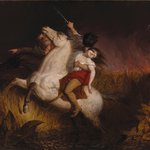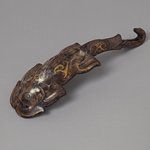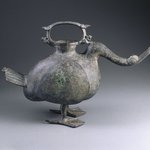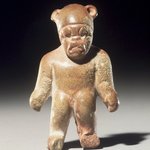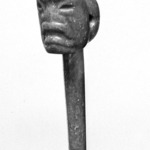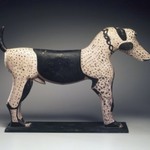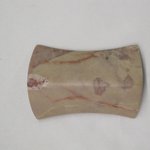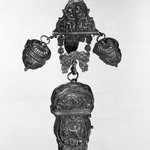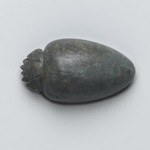
Spoon with Incised Designs
Arts of the Americas
The Olmec, whose civilization flourished on the Gulf Coast of Mexico from 1200 to 400 B.C.E., excelled at jade carving. The rarity, beauty, and hardness of the stone, with its variety of colors ranging from light green to a rich blue green, made it a desirable material for small objects. Jade was symbolically related to water, plants, and fertility. Spoons, often with incised designs, were likely used by shamans to ingest hallucinogens that induced visions and allowed them to communicate with the supernatural world. The shape of the plaque seen here is interpreted as a corn symbol, an indication of the crop’s importance. Images incised on Olmec celts (ceremonial axes) show figures wearing plaques like this one as headdress ornaments.
CULTURE
Olmec
MEDIUM
Jade, red pigment
DATES
800–500 B.C.E.
PERIOD
Preclassic Period or Middle Formative
DIMENSIONS
5 x 1 3/16 x 5/16 in. (12.7 x 3 x 0.8 cm) (show scale)



COLLECTIONS
Arts of the Americas
ACCESSION NUMBER
L73.15.1
CREDIT LINE
Collection of Christopher B. Martin, Dana B. Martin and Catherine S. Martin
CATALOGUE DESCRIPTION
Carved jade spoon with incised designs filled with red pigment (probably cinnabar). The spoon's slim handle widens into a bowl and then narrows into a smaller concave extension. The bowl is incised with a face in profile with typical Olmec features including the thick, drooping lips. Two other abstract, eyeless profiles appear in front of and behind the main profile head suggesting a mask that has been cut away to reveal a human face. Behind the head, a hand-paw-wing motif represents an abbreviated version of the Olmec dragon. The three, lobed designs incised in concentric lines on either side of the bowl have been interpreted as jaguar fur. Based upon representations of clothing, ornaments and ceremonial paraphernalia on stone sculptures, spoon-like objects appear to have been used by high-status individuals as insignia and worn (when there are drill holes) as pectoral ornaments. These spoons may have also been used by shamans for the consumption of hallucinogens to induce visions.
EXHIBITIONS
MUSEUM LOCATION
This item is not on view
CAPTION
Olmec. Spoon with Incised Designs, 800–500 B.C.E. Jade, red pigment, 5 x 1 3/16 x 5/16 in. (12.7 x 3 x 0.8 cm). Collection of Christopher B. Martin, Dana B. Martin and Catherine S. Martin, L73.15.1. Creative Commons-BY (Photo: Brooklyn Museum, L73.15.1_transp5629.jpg)
IMAGE
overall, L73.15.1_transp5629.jpg. Brooklyn Museum photograph
"CUR" at the beginning of an image file name means that the image was created by a curatorial staff member. These study images may be digital point-and-shoot photographs, when we don\'t yet have high-quality studio photography, or they may be scans of older negatives, slides, or photographic prints, providing historical documentation of the object.
RIGHTS STATEMENT
Creative Commons-BY
You may download and use Brooklyn Museum images of this three-dimensional work in accordance with a Creative Commons license. Fair use, as understood under the United States Copyright Act, may also apply.
Please include caption information from this page and credit the Brooklyn Museum. If you need a high resolution file, please fill out our online application form (charges apply).
For further information about copyright, we recommend resources at the United States Library of Congress, Cornell University, Copyright and Cultural Institutions: Guidelines for U.S. Libraries, Archives, and Museums, and Copyright Watch.
For more information about the Museum's rights project, including how rights types are assigned, please see our blog posts on copyright.
If you have any information regarding this work and rights to it, please contact copyright@brooklynmuseum.org.
RECORD COMPLETENESS
Not every record you will find here is complete. More information is available for some works than for others, and some entries have been updated more recently. Records are frequently reviewed and revised, and we welcome any additional information you might have.




